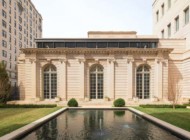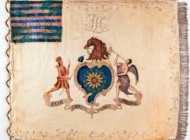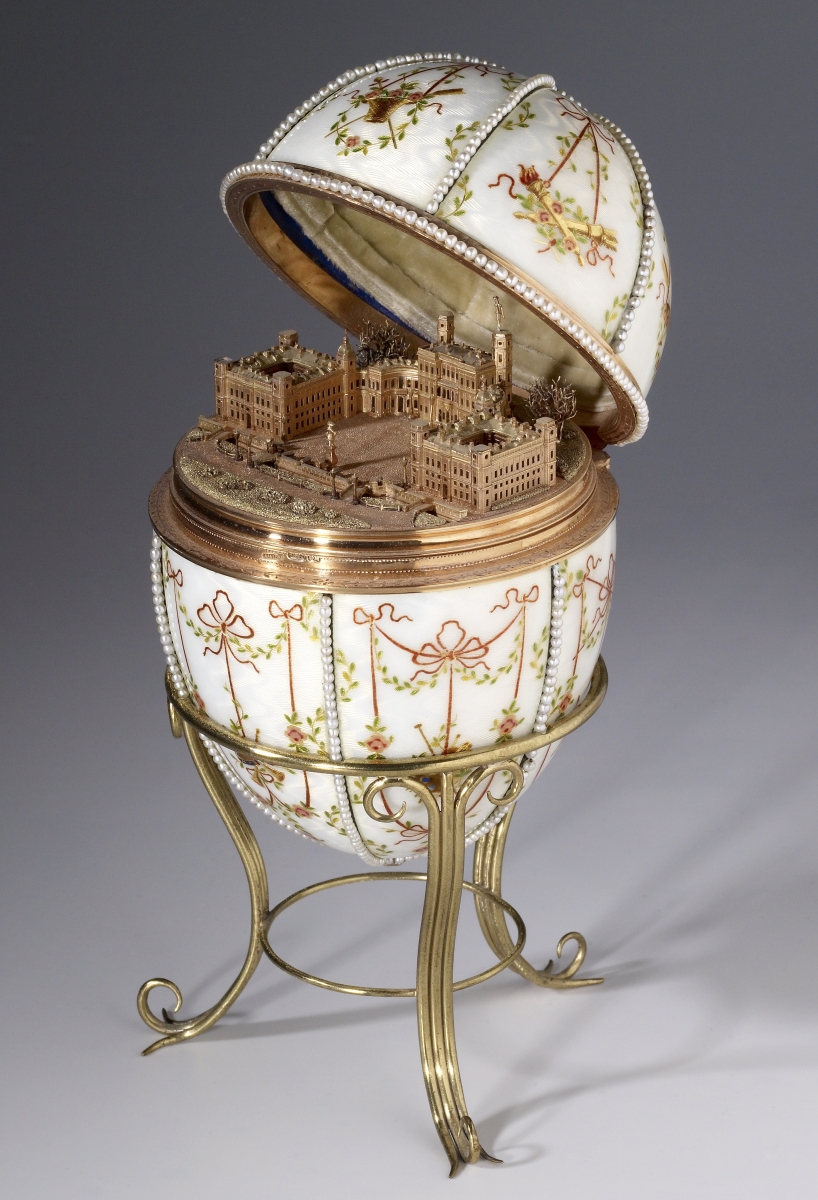
Tsar Nicholas II spent much of his childhood at the Gatchina Palace, south of St Petersburg. In 1901, he presented his mother Maria Feodorovna (1847–1928) with a Fabergé Easter egg enameled in the Eighteenth Century French rococo taste and studded with seed pearls. The egg opens to reveal a detailed golden miniature of the palace with rock crystal windows. Acquired from Alexandre Polovtsoff by Henry Walters, 1930.
By Karla Klein Albertson
BALTIMORE – “Fabergé and The Russian Crafts Tradition: An Empire’s Legacy,” the exhibition on view at the Walters Art Museum in Baltimore through June 24, is a project woven from many intersecting narrative threads. Among them, the show and its accompanying catalog explore the artistry of Carl Fabergé and his contemporaries, the cultural traditions that influenced Russian styles, the flight of Russian artists and aristocrats to Paris after the 1917 Revolution and the passionate collecting sagas of museum founder Henry Walters (1848-1931) and major donor Jean Riddell (1910-2010).
The collection begun by William Thompson Walters and expanded by his son Henry has notable strengths in so many areas – from Greek and Roman antiquities to Far Eastern ceramics and Impressionist art – that only through such a focused exhibition can the spotlight rest on other highlights. The current show brings together more than 70 objects from the museum’s permanent collection. Among them are two of the precious Fabergé Easter eggs commissioned by the tsars, as well as fantastic decorative creations of gold, silver and precious stones.
Two decades ago, the cataloged exhibition “Russian Enamels: Kievan Rus to Fabergé” displayed works from the Walters collection and from Marjorie Merriweather Post’s Hillwood Museum, the other great repository of Russian art in nearby Washington, DC. Since then, however, the Walters holdings in this field have been multiplied by the remarkable collection formed by Washington art patron Jean M. Riddell, who passed away in 2010 at the age of 100. To the museum’s good fortune, her selections complemented and fleshed out the choice of objects acquired by Henry Walters, giving visitors greater opportunities to compare and contrast styles and workmanship.
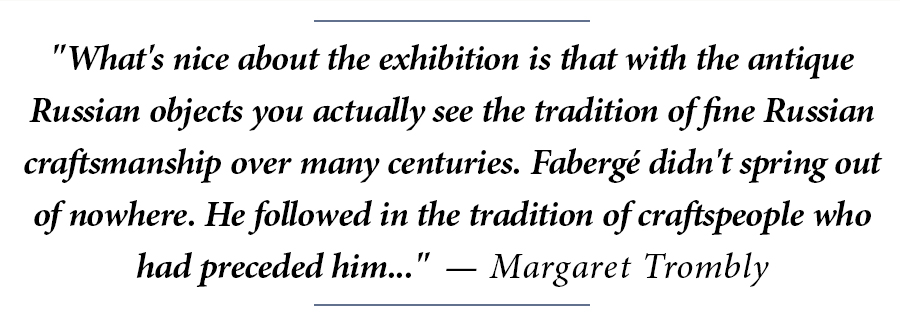 Jo Briggs, associate curator of Eighteenth and Nineteenth Century art, was the exhibition’s organizing curator at the Walters. She explained, “Like a lot of museums, we’ve been looking more at the history of collecting and how we acquired things – how they came to be in Baltimore. The question I always get from members of the public is, ‘How did this get here?’ We focused on the relationship between Henry Walters and the dealer Alexandre Polovtsoff, who was a Russian émigré in Paris. He ended up selling around 80 things to Henry Walters, including the two Fabergé Imperial eggs – the Rose Trellis and Gatchina Palace eggs.”
Jo Briggs, associate curator of Eighteenth and Nineteenth Century art, was the exhibition’s organizing curator at the Walters. She explained, “Like a lot of museums, we’ve been looking more at the history of collecting and how we acquired things – how they came to be in Baltimore. The question I always get from members of the public is, ‘How did this get here?’ We focused on the relationship between Henry Walters and the dealer Alexandre Polovtsoff, who was a Russian émigré in Paris. He ended up selling around 80 things to Henry Walters, including the two Fabergé Imperial eggs – the Rose Trellis and Gatchina Palace eggs.”
Briggs continued, “Furthermore, the idea bubbled up to celebrate the Riddell bequest featured in the catalog and also think about those objects from the history of collecting angle. The overriding drive was to put our Fabergé eggs in a much broader context. That includes an examination of what else Fabergé was making, what traditions he was drawing on, who were his contemporaries working at that time. Our collection, before-the Riddell bequest really skewed toward that Eighteenth Century aesthetic, which we know Henry Walters enjoyed from his collections of Sévres porcelain, snuff boxes and that sort of thing. He knew that rococo angle and he didn’t collect the Russian Revival material – that’s something we got through the Riddell bequest – but it’s nice to have both sides of the coin here. So, there’s the French influence, looking back to Catherine the Great, the old Russian style that looks to the folk tradition and then there’s a Japanese element that comes in and the influence of Chinese enamels. There’s a lot going on there, and I like the idea that we’re showing that variety.”
Walters’ interest in Fabergé and Russian art can be traced to 1900, when he sailed to St Petersburg in his steam yacht SS Narada, accompanied by his sister and brother-in-law and another couple. He met up with his old friend Princess Julia Dent Grant Cantacuzène-Speransky (1876-1975), the eldest granddaughter of President Grant, who took him to the recently opened Fabergé store. There he bought for himself a group of carved hardstone animals – Fabergé was a collector of Japanese netsuke – and elegant parasol handles to present as gifts. These are in the exhibition. Briggs added that he may have seen Fabergé’s exhibit of imperial treasures at the 1900 Paris Exposition. However, “He could never have known when he was sitting in that Fabergé store in St Petersburg that 17 years later there was going to be a Russian Revolution and eventually he would end up with the opportunity to buy those imperial pieces.”
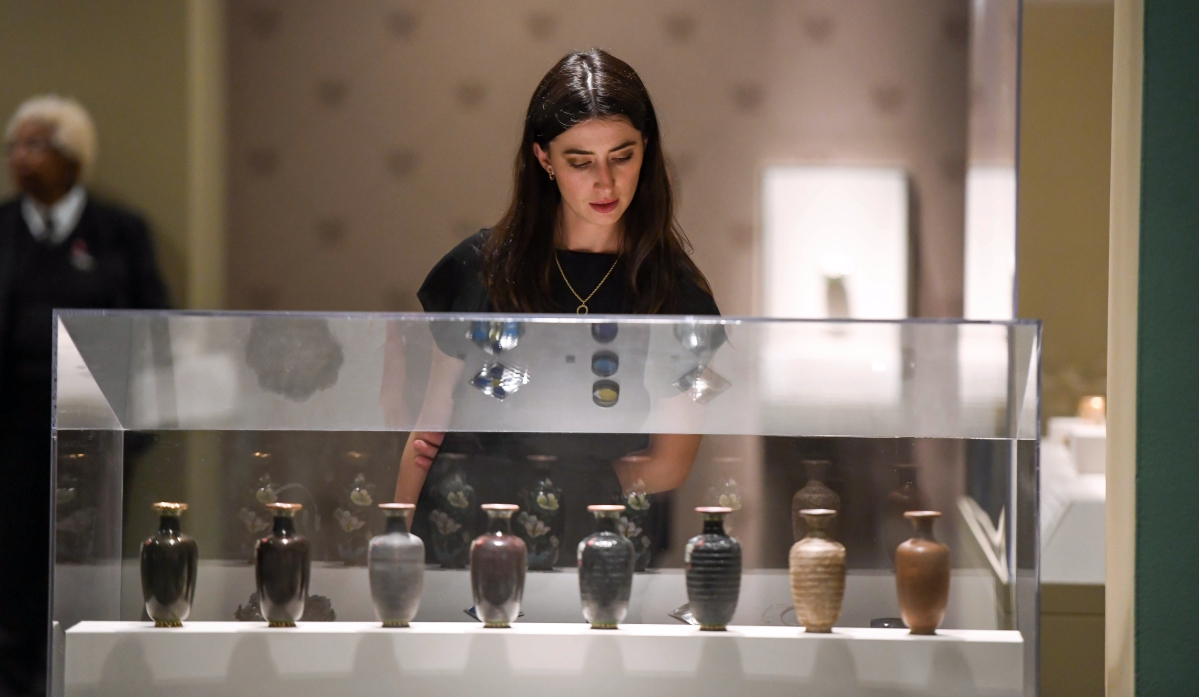
A visitor examines a series of vases illustrating the process of enameling used by Russian craftsmen. —Maximillian Franz photo
Essays in the show’s catalog focus on Alexandre Polovtsoff, the dealer who made possible Walters’ acquisition of the most important objects in his Russian collection. The volume was edited by exhibition co-curator Margaret Kelly Trombly, who was curator, director and vice president of the Forbes Magazine collection. Those holdings included a series of Russian masterworks, now repatriated to the country of their origin and on display at the Fabergé Museum in St Petersburg. She said, “Polovtsoff was an aristocrat, turned scholar, turned dealer. His background was that he was the grandson of Baron Stieglitz, who founded the Stieglitz Museum in St Petersburg, which not only had exhibition space, but also a decorative arts school attached, where students could learn enameling and goldsmithing.
“Alexandre Polovtsoff’s father married Stieglitz’s adopted daughter, who was purported to have been a member of the imperial family. So, our Polovtsoff grew up in very rarified circles,” Trombly continued. “He was a diplomat, scholar and curator at the Stieglitz Museum. When the Revolution came, he actually did the inventories of Gatchina Palace and also Pavlovsk Palace. Then he fled to Finland and from Finland to Paris. He was at home in Paris but he still had to make a living.”
In France, he became part of the community of around 100,000 Russians in exile – many members of the nobility and prominent artists – who had fled their home country for political reasons. Russian emigres in Paris became figures of romance and intrigue, as they were often portrayed in 1920s fiction and cinema.
With his curatorial background, Polovtsoff established himself as an art dealer in his adopted city. Henry Walters visited trusted dealers there. Jacques and Germain Seligmann, later Seligman, may have introduced him to the Russian in 1922. Emigres had treasures to sell, and Polovtsoff established himself as a broker between sellers and buyers, although the precise path of objects from Russia into Western hands is often mysterious. The introduction to the exhibition catalog states, “Although the exact purchase date and provenance of Henry Walters’ art acquisitions are often hard to determine, it is fairly certain that he bought 80 objects from Polovtsoff largely between 1928 and 1931…. Walters’ most spectacular acquisitions from Polovtsoff were the two imperial Eggs made by Fabergé as gifts for the Easter holiday within the Romanov family.”
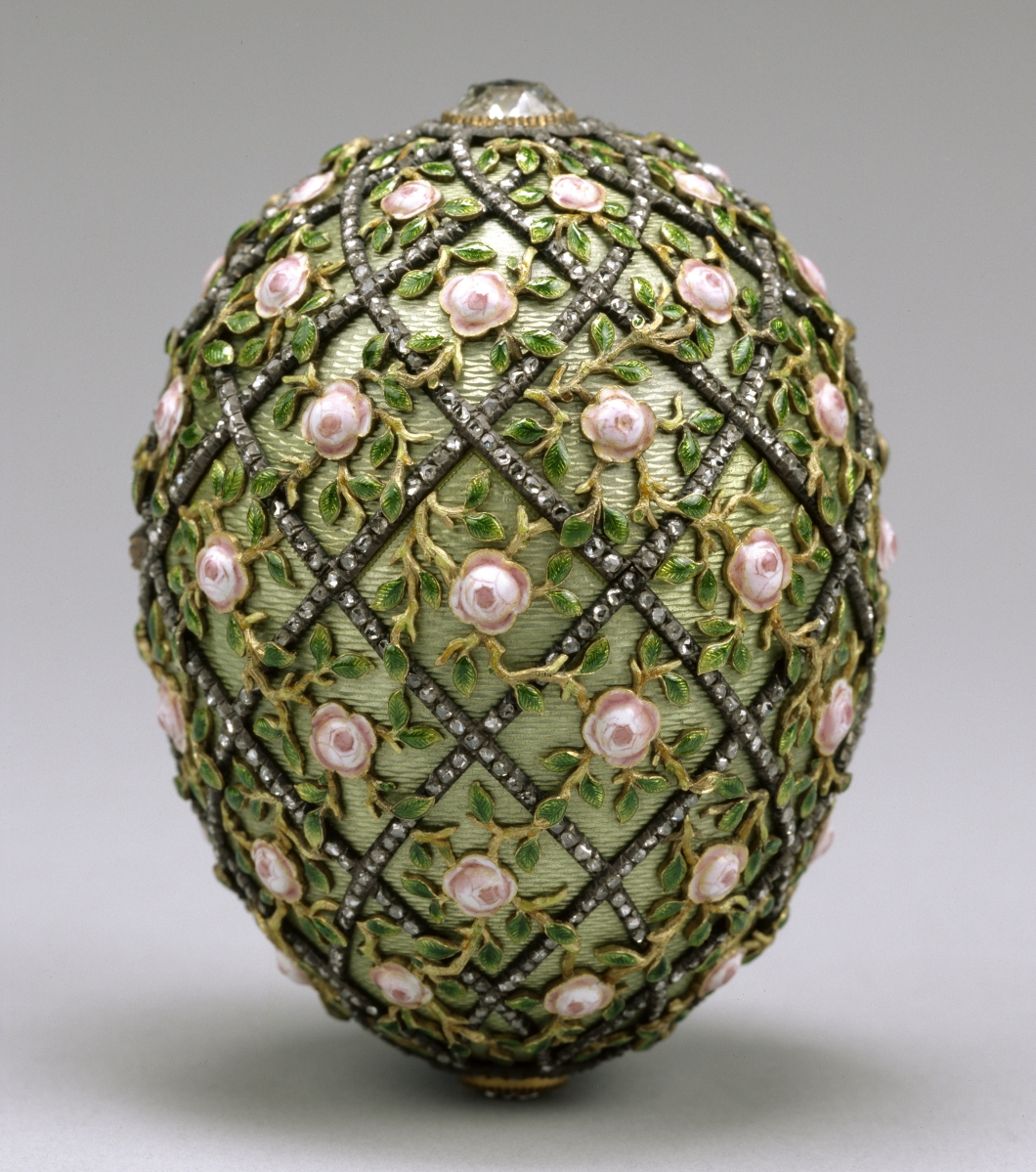
Made in the Fabergé workshop by Finnish master Henrik Wigström, the Rose Trellis imperial Easter egg was a gift from Tsar Nicholas II (1868–1918) to his wife Alexandra Feodorovna. The date “1907” can be seen under a portrait diamond at the apex. Criss-crossed with diamonds, this 3-inch-tall objet d’art originally held as its “surprise” a necklace with a miniature of Tsarevich Alexei Nikolaevich, now lost. Acquired from Alexandre Polovtsoff by Henry Walters, 1930.
Jean Montgomery Riddell’s collecting journey took a more familiar path. Her father was ambassador to Hungary under Franklin Roosevelt. She met Richard Riddell in Budapest and they settled in Washington, DC, where he became a realtor but also an antiques shop owner in Georgetown. After his death, the artistically inclined widow pursued a serious interest in Russian decorative arts, with special attention to the Russian Revival pieces made in Moscow workshops between 1870 and 1917. She made her acquisitions through the well-known dealers Leo Kaplan Ltd and A La Vieille Russie in New York City. She sought out the works of two women silversmiths, Maria Adler and Maria Semenova, and gathered an important body of work by the Moscow firm of Pavel Ovchinnikov. She also admired the inventive workmanship of enameler Feodor Ruckert, who worked independently and for Fabergé. Visitors can see eight of his creations on view in the galleries.
Although there are objects by porcelain and glass factories, goldsmiths and jewelers, the colorful art of enameling and its creative techniques are at the heart of the story presented in the exhibition and catalog. Visitors pause at the Fabergé imperial eggs, clad in envelopes of shimmering enamels, and admire the incredible workmanship involved in creating the cloisons that capture liquid color on the decorative cups and boxes. Viewers learn about the complex process of plique-a-jour enameling, in which open metal cells are filled with translucent pigment. The combined Walters and Riddell collections illustrate an encyclopedia on the art of enameling.
Margaret Trombly said in conclusion, “What’s nice about the exhibition is that with the antique Russian objects you actually see the tradition of fine Russian craftsmanship over many centuries. Fabergé didn’t spring out of nowhere. He followed in the tradition of craftspeople who had preceded him, many of whom had worked for the court of Catherine the Great. Visitors will see a contrast between the beautiful and intimate Fabergé pieces from St Petersburg and the Russian Revival pieces favored by the Muscovites. The goal is to familiarize people with the artistry that was expressed over many centuries and culminated in those imperial eggs. By displaying these things and familiarizing people with their history, more and more information will come out.”
The Walters Art Museum is at 600 North Charles Street. For information, 410-547-9000 or www.thewalters.org.
Journalist Karla Klein Albertson writes about decorative art and design.

















